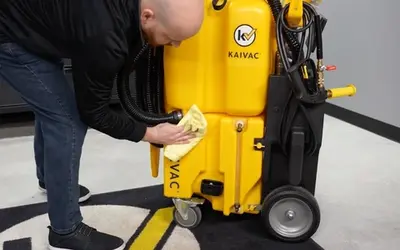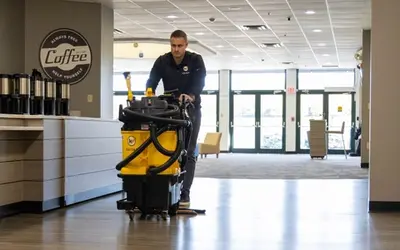The Importance of Winter Floor Care for Customer Safety and Satisfaction

As winter rages on, it’s a good time to reassess winter floor care protocols. Floors, the first thing people notice when they walk into a retail space, already endure an incredible amount of wear and tear. Colder, wetter weather makes things worse, adding new safety risks for your customers and employees while wreaking havoc on flooring materials.
The problem is twofold. Pooling moisture from rain-soaked umbrellas, snowy coats, and ice-incrusted boots increase the chance of painful – and expensive – slip, trip, and fall accidents. Sand, road salts, and ice melt, applied to make walkways and parking lots safer, also find their way inside. These materials degrade the floor’s finish, prematurely age the surface, and create an ugly, unsatisfying experience.
Dangerous, ugly floors are not what shoppers crave, especially in this year of pent-up demand. On-line shopping may be here to stay, according to Square’s 2022 Future of Retail Report, but the report also discovered “a palpable joy people get when shopping at stores” finding an overwhelming 92% of consumers still miss in-store shopping. Even die-hard eCommerce fans are not ready to go completely digital as 56% of shoppers “still like to visit a store before making a purchase online,” according to research from Retail Drive.
A robust winter floor care program encourages that “palpable joy” while protecting customers and employees alike. Here’s how proper winter floor care increases safety, protects expensive assets, and creates a welcoming, satisfying shopping experience all season long.
Wet Floors are Dangerous Floors
Bad weather makes your store more dangerous for customers and employees. Nearly half of all slip and fall incidents occur between the cold, wet months of December and March. These accidents can be serious, with slip and falls accounting for over one million emergency room visits a year, according to the National Floor Safety Institute. Common injuries include lacerations, broken bones, and head injuries.
They can also be costly. The national average cost of a typical slip and fall injury is $20,000, while the cost to litigate a slip and fall claim is up to four times that. When an employee misses several workdays with a slip and fall related injury, worker’s comp insurance costs skyrocket. Defending against slip and fall claims costs retail stores and supermarkets a whopping $450 million a year.
Moisture is Not the Only Threat
Slippery puddles caused by rain, snow, and ice are not winter’s only threats. Road salt and ice melt chemicals, put down to make sidewalks and parking lots safer, become hazards once tracked into you store.
If left in place road salts leave an unsightly white residue that mar floor finishes. Ice melt turns slightly oily, creating another slipping hazard that will also damage floors. These chemicals can also build up inside an autoscrubber, damaging expensive equipment
The Best Winter Floor Care System
Surprisingly, protocols used to clean these unsafe messes can lead to more slips, trips, and falls. Increased mopping soaks up some liquid, but not all of it, leaving floors damp and slippery. Ironically, Wet Floor signs are also tripping hazards as are cords from wet/dry vacs and other plug-in cleaning equipment.
The best winter floor care protocols limit risks by preventing most moisture and chemicals from entering your store and then fully removing any that do squeak by.
Prevention starts at the entrance with a robust matting system that grabs and holds on to dirt, chemicals, and moisture. This article explains the benefits and differences between entrance mats and where to place them during normal weather conditions.
Harsh winter weather, however, requires even more matting and ramped up mat care. Mats fill up with moisture, chemicals, and grit quickly during bad weather and need to be “emptied” several times a day for optimal winter performance. A wet/dry vac removes moisture and soils from mats quickly but be mindful of the cord if a plug-in machine is used (or choose a cordless version instead).
As great as they are, mats can’t scrape off or soak up all of winter’s chemicals and moisture. Anything that escapes the mats should be removed from floors quickly and completely. Choosing the right tool for this task can make the difference for your customers and employees.
A bucket and mop might seem like a good option, but mops leave a lot of moisture, salts, and ice melt chemicals behind. An advanced cleaning machine works better than a mop. These battery-powered tools use a powerful vacuum to fully remove dangerous water and damaging chemicals. The result are clean, dry floors that are safe all season long.
A good winter floor care program will keep your store (or any facility for that matter) safe and inviting no matter what the weather brings. Click here to find more was to delight your customers, protect your staff, and grow your bottom line.
Related Posts

Preventive Maintenance for Your No-Touch Cleaning® System
Your Kaivac No-Touch Cleaning system makes restroom maintenance fast and easy. Keeping your No-Touch Cleaning system in good working order is also fast and easy. Kaivac makes performing preventative maintenance and troubleshooting potential issues simple. No special equipment or technical expertise required.
Read more
A System for Every Aisle: How Kaivac Delivers Complete Grocery Store Cleaning Solutions
Kaivac’s integrated Grocery Suite streamlines cleaning across every store zone, cutting labor, reducing cross-contamination, and delivering faster, deeper hygiene results for safer, fresher stores.
Read more
How to Clean Worship Facility Floors
Worship facilities need clean, safe floors to best serve their congregations. Here’s how tools from Kaivac keep worship facilities clean from the entry to seating areas to kitchens and more.
Read more